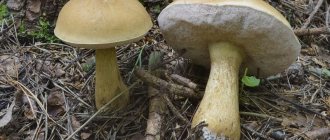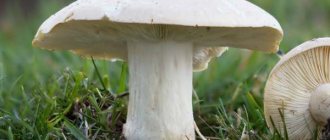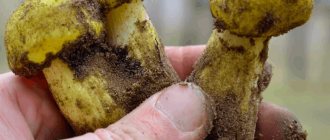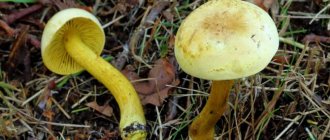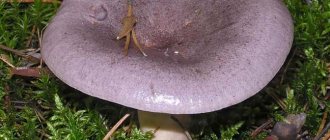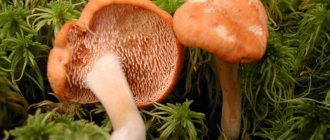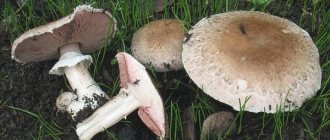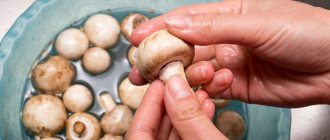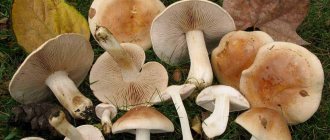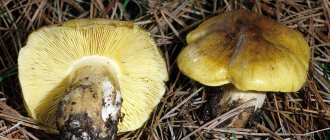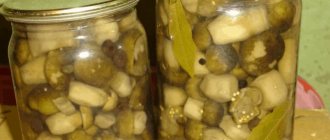Collecting and eating green mushrooms
Enjoying the harvest, lovers of “quiet hunting” will certainly take greenfinch mushrooms into their baskets. In winter and spring, they will perfectly decorate the table and are suitable for preparing salads and marinades.
The row has a dense fleshy cap of yellow, green or yellowish-olive color with a diameter of 4 to 12 cm.
Greenfinch (greenweed or golden rower) belongs to the rower family and belongs to the genus Lamelidae. The bulk of this species is conditionally edible; consumption is possible only after processing: pickling, fermentation, decoction. It lives in Russia in coniferous and mixed forests, on dry sandy soils. Sometimes they can be found in deciduous forests, under aspen trees, where they will be large in size.
The mushroom is collected at the end of August and until the beginning of November.
Hot appetizer of greenfinches
One of the original recipes for preparing this mushroom is ham envelopes with greenfinches. Need to prepare
- greenfinches – 300 g;
- ham – 200 g;
- onions – 2 pcs;
- lard – 50 g;
- salt and black pepper - to taste.
Mushrooms are finely chopped and stewed with onions, lard, and spices. Then the mushrooms are cooled a little, after which they are laid out on a thin slice of ham, which is wrapped in an envelope. The envelopes prepared in this way are placed on a pre-greased baking sheet and baked in the oven for a short time. The mushroom dish is served with lightly toasted and salted white bread.
Description of the golden row
The row has a dense fleshy cap of yellow, green or yellowish-olive color with a diameter of 4 to 12 cm. In young plants it is flat-convex with a tubercle on top, in mature plants it is spread out with raised, slightly wavy edges. Upon reaching adulthood, the cap darkens. The skin is thick, smooth to the touch, in rainy weather it becomes slimy and covered with soil particles and adherent leaves. This is due to the fact that the cap has small scales to which foreign bodies stick.
On the reverse side, the cap has frequent and thin plates 5-12 mm wide, lemon-yellow, sometimes greenish-yellow. When broken, the flesh is dense and white. The mushroom is less susceptible to infection than other brethren, and is practically never wormy. If you make a cut, the color on it does not change. When inhaled, the odor has a floury tint and an unexpressed taste. Experienced mushroom pickers note that the most pronounced smell is characteristic of rows that grew in a pine forest.
Greenfinch (greenfinch or golden rower) belongs to the rower family and belongs to the genus Lamelidae
If you pay attention to the leg, it is short and thickened towards the bottom, completely hidden in the ground. The color is yellow or yellow-green, depending on the age of the fungus.
Collecting greenfinches brings additional trouble to mushroom pickers. Hidden prey must be found, properly cut, and then cleaned of sand and leaves before placing in the basket.
The green grass often grows on the sides of forest roads and is hidden under fallen leaves so that the cap is barely visible. Sometimes you can find a single specimen, but most often in a group. You can immediately find graylings and greenfinches together, which makes the collection even more enjoyable. Greenfinch has doubles, rows similar to her. You can distinguish them by their unpleasant smell. They are a little smaller and not as meaty. Often young mushroom pickers do not collect young green stuff because they are afraid of confusing it with toadstool. Externally, the difference is visible both in color and structure.
Its poisonous counterpart has a ring on the stem and the flesh is not so elastic.
Doodle sharks
If everything is more or less clear with the species common on the coast, then with some types of fish that are caught off the coast of Yalta, not everything is so simple. Take, for example, the Black Sea katran or its relative, the sea fox. These sharks are not common trophies of fishermen - in order to catch a katran or a fox, you need to know their habits well and the places where the likelihood of their habitat is high. But even if you are lucky enough to pull a sea fox or katran out of the water, then another question arises - what to do with them now, how to cook?
Katran is a fish with white dense meat. And in recent years, even dried and smoked balyks from katran have appeared in the fish markets of Crimea. But in Yalta, experienced fishermen know that it is best to make cutlets from freshly caught katran.
And here there are special nuances - you can’t just fry fresh katran meat - it will give off a strong ammonia, which will ruin the whole dish. Therefore, before preparing katran cutlets, thick skin is removed from the fish carcass and the cartilaginous spine is removed. After which, the meat is cut into strips 5 centimeters thick and soaked in a soda solution - a tablespoon per liter of water. The fish should be soaked in this solution for three to four hours to remove the ammonia smell.
After this, the soaked fish is passed through a meat grinder with onions and mixed with the crumb of the loaf. After which the minced meat is seasoned to taste and cutlets are formed and fried in breadcrumbs. Fish cutlets made from katran meat are very tasty, especially if you fry them in fat rendered from the katran liver. Then the fishy taste will be preserved without the taste of vegetable oil. However, the main caveat is that katran cutlets are only tasty when they are hot. It's not very pleasant to eat them cold.
With sea fox it’s a little easier - you don’t have to soak it in a soda solution, but there’s much less meat in sea fox than in katran. Therefore, the old Yalta fishermen were not particularly fond of this catch either. However, for big lovers of marine exotica, we can recommend cutting the fox into strips 10 centimeters long, first cutting off the thorns and bugs from the skin, frying it on both sides, and simmering it in tomato sauce or with tomatoes in a frying pan. The result will pleasantly surprise you.
Nothing stands still, over time, the recipes for preparing the gifts of the Black Sea change - something comes into fashion, some fish go out of mass use, but the main thing that brings pleasure is the freshness of the catch and imagination in preparation.
The most noticeable fish on the Black Sea coast is the roulena, or, as the locals call it, the greenfinch. This fish is notable for its bright sides. Already from the name it is clear that the main colors of rolls are green. Anapa tourists and divers who love to watch underwater life encounter this fish even in shallow water. Zelenukha in Anapa is one of the most unafraid representatives of the marine fauna. The fact is that Zelenushka meat is not very popular among urban gourmets; there is practically no fishing for Rulena. The fish is accustomed to the friendly attitude of people and allows them to come close to them. Despite its bright outfit, greenfinch is absolutely safe for humans.
Rulena's body is oval and laterally flattened. The head is large, the snout has a distinct hump, and the mouth is decorated with protruding lips, like a modern pop star. Under the lips in the oral cavity there are small, even teeth; on the upper jaw there are twice as many teeth. The dorsal fin is one undivided, the tail has soft rays, folds well and opens when swimming.
The coloring of Greenfinch closely depends on the external environment, with males being much brighter than females, especially during the mating season. The main colors of the fish are green and olive, with lilac stripes on the sides. Juveniles of the sea roulena are not at all bright, usually brown or light green with a light belly. Males can grow up to 35 centimeters and weigh up to 500 grams. The opposite greenish floor has a length of 25 centimeters. The lifespan of our Greenfinches is about 15 years.
Roulens live in the coastal zone of the Anapa resort, inhabiting depths of up to 70 meters. You can see the fish in their favorite rocky places covered with abundant algae. Black Sea roulens live in small schools, but, nevertheless, each individual captures its own area, which it zealously protects from relatives and other fish.
The main food of adult greenfinches are mollusks and bottom worms. Sometimes small bivalve shells are eaten, which the fish swallows and opens with powerful jaws.
Experts are of the opinion that adult and strong Greenfinches, due to the structure of the muscles of the swim bladder, can produce low-pitched sounds. It is not yet known for what or for whom this marine music is intended.
There are gourmets in Anapa who claim that the gastronomic properties of green fish meat are not inferior to the taste of the famous mullet or garfish. It is necessary to properly prepare the roulena carcass in order to truly enjoy this exotic and tasty dish.
The sea pebble beaches near the resort of Anapa are rich in schools of green fish. During the summer holidays, greenfinches begin mating time in shallow water. A curious diver can easily spot schools of roelids among the rocky underwater ridges of the High Coast of Anapa.
The sea greenfish readily falls on a fishing hook. You can take a closer look and hold the roulena in your hands while sea fishing in Anapa. Greenfish attack both artificial baits such as wobblers and fresh shrimp or even bread.
Wrasses, or greenfinches in common parlance, are typically marine, euryhaline fish and can live in bodies of water with different salinity levels from 12 to 38 ppm and higher. In addition, wrasses (labrids) are eurythermal, i.e., they are adapted to living in bodies of water with different temperature conditions and are able to withstand significant decreases or increases in the temperature of the aquatic environment. In terms of their feeding habits, wrasse are typical benthophages, searching for food at the bottom of reservoirs and preferring bivalves, crustaceans, marine worms and algae. Unlike many other fish species, until recently wrasses were not considered in the world ocean fisheries as priority fishing targets using medium and large-tonnage trawlers.
Zelenukha - Quail Wrasse, or Spotted Wrasse, Hazel Wrasse, Green Wrasse, all these types of fish can be called approximately one species - Zelenukha (in common parlance), this type of fish densely populated not only the Black Sea, but also the Mediterranean Sea, as well as all wrasse live only in coastal areas of the sea, hiding from larger fish in sea thickets and rocky crevices. These fish usually live alone, or less often in small schools, in coastal areas of the sea among rocks and stones overgrown with algae at depths from 1 to 50 meters. They are also found in sandy lagoons. They usually do not migrate to the sea and winter here, near the shore, or at a slightly greater depth, among rocks and stones.
All wrasse have fairly strong-looking teeth, which helps them easily crush both the shells of small crabs and growing vegetation, which is interesting for this type of fish. All wrasse (greenfish or the so-called large species - rolls) are often caught on a fishing hook, usually fishermen who catch such a trophy throw these fish away because of the unpleasantly sweet taste of the meat, but larger caught specimens are also taken home like other caught fish ( mullet and horse mackerel, goby and sea ruff).
Family wrasse or labridae (labridae) Wrasse family belongs to the order Perciformes and the suborder Labroidei and is extremely diverse - it includes about 50 genera and has up to 600 species. In terms of their biological and genetic characteristics, many wrasse are typically eurybiont species, capable of living in marine reservoirs of varying ecological conditions. Among the wrasses there are such giants as the Napoleon fish from the genus Cheilinus, reaching 2.3 m, weighing about 190 kg and considered a valuable commercial object.
It lives in the seas washing the southern and western coasts of Europe, in Ukraine it lives in the coastal zone of the Black Sea (off the coast of Crimea and the Caucasus), and enters the Kerch Strait. It lives mainly in the coastal zone, among rocks and stones overgrown with algae. Searches for food during the daytime. The way it feeds is very characteristic: the greenfinch sifts through a huge amount of sand, separating food from it. They feed on bottom invertebrates, mainly mollusks, the shells of which are crushed with special strong teeth located in the throat. They have less success with small crustaceans and polychaete worms.
First of all, greenfinches, both Black Sea and tropical, are quarrelsome and pugnacious. They live “unsociable”, alone, each occupying their own territory, which is strictly protected from any unwanted visitors and especially from individuals of their own species. According to another version, greenfinches do not lead a solitary lifestyle, but live in family clans. They consist of parents and children. Sometimes these clans, as scientists believe, may include several families who jointly defend their ancestral domains. Only adults, mostly males, participate in all kinds of territorial “disputes” and conflicts. The green baby, to put it in literary language, does not get involved in these matters and does not get underfoot.
Briefly about the building abilities of greenfinches. They appear in the periods preceding spawning. The wrasse's nest is crescent-shaped. In the middle of it, the male dug a small depression filled with fragments of shells, which the head of the family collects at the bottom and brings to the nest in his mouth. When the eggs are laid, he carefully collects all sorts of scraps of algae and covers the clutch on top so that various thieves do not discover and attack the eggs.
As usual, laying is preceded by a period of “courtship” in greenfinches. In different species of these fish, the males “persuad” the females to lay eggs not according to the standard. Some are delicate and patient, and there are those who act downright “impudently”. His color changes at this time, and with a ferocious look he digs a hole in the sand for the nest, rushes in all directions, bites and hits the females until he intimidates or charms one of them so much that she goes with him to the nest and fills it caviar." He does this with females. You can imagine how he behaves with “brothers” of the same sex or with someone who encroaches on his nest.
The greenfinch has an oblong, laterally compressed body. The dorsal fin is long, with a shorter soft part. The anal fin is slightly longer than the soft part of the dorsal fin, with three spines. The caudal fin is rounded. The small retractable mouth is armed with small fang-like teeth arranged in a single row. Females and juveniles are modestly colored: the general background of their body is gray-green or brownish, shimmering with silver on the belly.
Adult males are very bright, especially during the spawning period. Their light green, blue-green or green-yellow body is lined with longitudinal rows of red spots, and the upper part of the head is bright blue; blue, green, red and yellow stripes and spots alternate on the fins. This species is very characterized by numerous small dark spots, forming three or four indistinct longitudinal stripes along the body. In adults, a small black spot is clearly visible at the base of the caudal fin and a large dark spot above the pectoral fin. Adult greenfinches can reach a length of 35 cm; fish 20-25 cm long are usually found.
Greenfinches reach sexual maturity early: females in the second year of life with a length of about 10 centimeters, males in the second or third year with a length of about 10.5 cm. In the Black Sea they spawn in May-June, in several portions. In places protected from waves, at a depth of 2.5-3 meters, males build round or oval nests of algae, 10-20 centimeters in diameter. Having completed the construction, the male drives the female into it, which lays eggs on the steep walls.
Soon the next partner takes her place, and eventually several females lay eggs in one nest. Each of them lays a total of 12 to 58 thousand eggs per season. The male covers the clutch with algae and begins to protect his offspring, constantly being above the nest. The development of eggs in our waters lasts from five to eight days, in the Mediterranean Sea - four days. Juvenile greenfinches are found in Novorossiysk Bay all winter. These fish grow slowly, and by the age of seven, males reach a length of 26, and females - 20 cm. Life expectancy is from 14 to 15 years. Greenfinches have no commercial value and become prey only for amateur fishermen.
The taste of roulena, or wrasse, has been valued for a long time. Among the ancient Greeks and Romans, it was often served along with red mullet at dinner parties. Skilled vase painters depicted these fish on special fish dishes. These dishes were flat, long, with a depression in the middle for sauces or salt. As for dishes prepared specifically from wrasse, many recommend smoking it in a special barrel-smokehouse, with the addition of firewood such as juniper and Christmas tree cones.
Benefits and harms
There is a lot of controversy about the benefits and harms of this mushroom. Most sources classify the mushroom as conditionally edible, although many modern scientists believe that the greenish color, which does not lighten after boiling, can cause a toxic threat to the body. Other biologists have the opposite opinion. The greenfinch mushroom is rich in amino acids, vitamins, fatty substances and contains a lot of phosphorus. Back in the 20th century, scientists identified a serum that kills staphylococcus. The mushroom can also thin the blood and prevent the formation of blood clots. A complex compound that can fight osteoporosis has been found in the rowan body extract.
If you pay attention to the leg, it is short and thickened towards the bottom, completely hidden in the ground
Lovers of golden rowan appreciate it for its excellent taste. They are consumed salted, pickled and fried, although cooking takes a lot of time. Cleaning a mushroom from dirt is not so easy.
Nevertheless, cases of poisoning with brilliant greens have been reported. Occurred as a result of excessive use and were characterized by the following sensations:
- severe weakness in the body;
- muscle pain;
- dark color of urine;
- convulsions.
If you prepare mushrooms wisely and eat them in small quantities, you can diversify your winter menu and pamper yourself with vitamins.
"Inedible" greenfowl
Often, local old-timer fishermen in Yalta only smile slyly when they see how visiting tourists, while fishing, rejoice at the large rainbow fish they have caught on the hook - the greenfish, as the locals call it. The reason for the smiles is simple - in Yalta, greenfish have long been not considered a commercial fish and fishermen usually released them into the sea, since they bite very actively near the shore. The reason for the disdainful attitude towards this fish of the perch family lies in the low taste of its meat - the greenfish does not differ in fat content, like perch or bluefish, or in its special taste. Its meat is dense and watery, and they didn’t really eat it either - in a word, it’s a trash fish.
However, about 10 years ago, I had the opportunity to try a product that was new even to me - hot smoked green leaf. And it turned out that the Yalta know-how - smoking formally inedible fish - revealed a different side to this beautiful fish. When smoked, it is quite edible and has its own special taste.
Preparation of golden row
Before using the row, it is necessary to carry out heat treatment. It should not be consumed fresh. Experienced mushroom pickers know what a wonderful taste green mushrooms have and how to prepare dishes.
Before preparing greenfinches, you must thoroughly clean the mushroom from sand and soil. To do this, rinse under running water, tapping the cap. Then soak in warm, salty water for 2 hours, as a result the sand will fall to the bottom of the container. Then you can start the simplest thing - cooking.
Pour cold water over the mushrooms, bring to a boil and add some salt. They should be cooked for about 20 minutes over low heat. The water is drained, a cold stream is poured over the greenfinch, and they are ready to eat. It is good to prepare a salad, marinate, fry, season various dishes, sauces, casseroles.
Read also: False honey mushrooms: what they look like, description, where they grow, how to distinguish them from edible real mushrooms, photos, videos
Another original recipe for serving is salted rows with mustard. To prepare the dish, you will need:
- 1 kg greens;
- 30 g dill seeds;
- 2 cherry leaves;
- 2 blackcurrant leaves;
- 3 bay leaves;
- 15 g mustard;
- 2.5 tbsp. Sahara;
- 6 black peppercorns;
- 1.5 tbsp. salt.
The mushrooms must be washed and cooked for 10 minutes, then cooled and placed tightly in a jar. Place bay, currant and cherry leaves between them. Prepare a brine from 1 liter of water, salt, sugar and pepper. Add dry mustard to a boiling pan, mix well and leave for 10 minutes. Pour light brine into a jar with mushrooms. Roll up or cover with a lid and put in a cool place to pickle for 7 days. A wonderful appetizer is ready.
Fried greens are very aromatic. To do this, cool and chop 500 g of boiled mushrooms. Sauté onion (1 head) in oil until golden brown. Place the mushrooms in a frying pan and fry for 10-15 minutes. Pour in 4 tbsp. sour cream and simmer over low heat for another 15 minutes. At the end, add salt and pepper to taste. The aromatic mushrooms are ready. Serve with potatoes.
Pickled greens have a wonderful taste. They are boiled until tender, distributed into jars and poured with hot marinade, adding vinegar essence. The marinade recipe is simple: add 1.5 tbsp to 1 liter of boiling water. salt, 6 peas of allspice, a bud of cloves and 1 tsp. vinegar.
It is not recommended for a person to eat large quantities of mushrooms, especially greenfinches. In addition to the necessary substances, the rows contain toxic substances that can cause poisoning. People suffering from stomach disorders should avoid eating greenfinches altogether.
Golden row is the last mushroom of autumn. It will be a good addition to dishes and will bring vitamins to the table. A varied menu prepared with mushrooms will leave pleasant notes of autumn.
Selection and preparation of ingredients
To prepare various dishes with green mushrooms, you usually take fresh mushrooms that grow in the forest in early September. They can be dried, pickled, fried and boiled.
Did you know? Several centuries ago, in Europe, the greenfinch mushroom was considered a delicacy, and in medieval France, peasants did not have the right to collect it in forests owned by nobles.
To prepare the product for further culinary processing, perform the following steps:
- fruiting bodies are cleaned by hand from leaves and debris;
- damaged and wormy areas are cut off with a knife;
- To better wash off dust and dirt, it is recommended to soak the mushrooms in clean water for 10–15 minutes;
- The cap and stem are washed with a soft kitchen sponge, and then rinsed again in running water.
Botanical description
The greenfinch mushroom, also called the green row mushroom, comes from the venerable mushroom genus Lamelidae and is part of the row family.
Its cap, which can grow to a size of 15 centimeters in diameter, is slightly convex at a young age and becomes flat over time. It has a light olive color with a predominant green tint, which noticeably turns brown towards the center.
On the back side of the cap there are yellowish-green plates, and the mushroom stem is almost entirely hidden in the ground. The flesh of the mushroom is yellowish in color, quite hard, fragile and very resistant to damage by worms.
Where they grow and when to collect them
Green rower grows exclusively on sandy soils, especially readily settling in coniferous forests, among which it primarily chooses pine forests. It can grow completely alone, but does not avoid companies of up to eight copies.
Greenflies are of particular value in the eyes of mushroom pickers because of their ability to emerge from the ground during that sad period when the main types of edible mushrooms end their growing season. The green row can be harvested from September until frost. And it is distributed throughout the Northern Hemisphere in its temperate latitudes.
Edibility and taste
Greenfinch belongs to the conditionally edible mushrooms. That is, it cannot be consumed raw, but it is quite possible after cooking. True, the latest scientific research suggests that it is toxic. However, the toxicity of this mushroom with fatal consequences has been recorded only with its excessive consumption.
The taste of the green row is weak, but there are discrepancies about its smell. Some people think it has a floury aroma, while others think it has a cucumber aroma.
Is it possible to eat green rowan
Green row is a conditionally edible mushroom. It has been proven that the skin and pulp contain toxins that have a negative effect on the human body. Even prolonged soaking and heat treatment do not lead to their complete destruction. Excessive consumption of greenfinches can cause food poisoning, disorders of the cardiovascular system and kidneys. It is believed that the largest amount of toxins is in the skin, and if it is removed, the problem will be solved. But that's not true. Toxins are present throughout the fruiting body and this must be taken into account. Green rower can be eaten only in cooked form and in small quantities.
The nutritional value
Greenfinch is not very high in calories, having only 19 kilocalories for every hundred grams. It consists of 46% protein, rich in valuable amino acids.
The other part of its composition, 49%, is occupied by carbohydrates, represented mainly by glycogen. And the fats present in the composition (5%) are mainly expressed in the form of phosphatides, lecithin and cholesterol.
Green grass protein has a whole range of amino acids beneficial to humans:
- tryptophan;
- arginine;
- lysine;
- serine;
- valina;
- glycine;
- histidine;
- threonine;
- isoleucine;
- aspartic acid;
- leucine;
- glutamic acid;
- methionine;
- phenylalanine.
- cystine;
- proline;
- tyrosine;
- alanine
Greenfinch is very rich in micro- and macroelements, among which the most is phosphorus, and also includes:
- iron;
- potassium;
- calcium;
- magnesium;
- zinc;
- selenium;
- sodium;
- manganese;
- copper.
Vitamins are also well represented in this mushroom in the form of:
- vitamin C;
- vitamin B6;
- vitamin B12;
- vitamin E;
- riboflavin;
- thiamine;
- vitamin D;
- vitamin D2;
- nicotinic acid;
- vitamin K1;
- pantothenic acid;
- folic acid;
- choline
Read also: Beneficial properties and harms of milk mushrooms, existing contraindications
Is it possible to confuse or similar species?
When collecting greenfinch, there is a danger of confusing it with similar mushrooms, which can cause significant harm to human health. For example, the poisonous sulfur row, which has some similarities with it, also grows in coniferous forests and has the same ripening period.
You can distinguish this toxic row from the greenfinch by the smaller size of the cap, by its bright yellow-gray color, and also by the unpleasant smell of the pulp.
Gray poisonous row Another one - spruce, or sultry - is not as poisonous as sulfur, but is considered inedible and differs from greenfinch in its smaller size and high, thin stem.
Spruce row
How to salt and pickle greenberries in jars for the winter
Greenfinches are common mushrooms with a dubious reputation. Despite the general opinion about their toxicity and frequent cases of poisoning, these forest gifts remain beloved in many Russian families.
It is believed that proper salting or pickling of greenfinches cannot cause harm to health, but on the contrary, will provide gastronomic pleasure. We suggest you consider how to prepare greens or greens for the winter.
- 1 Primary processing
- 2 Cold salting method
- 3 Marinated mushrooms
What can you cook from them?
Greenfinch is suitable for any type of culinary processing that exists for mushrooms. It can be boiled, fried, pickled, salted and dried.
Greenfinch grows in sand, mainly in pine forests, and, having a very sticky skin on its cap, collects a considerable “harvest” in the form of sand and pine needles. Therefore, when preparing it, the most difficult thing is to thoroughly clean it of debris. The cap is peeled, and sand and pine needles that get on the plates and stem are best removed by cooking.
As a rule, only young mushrooms are pickled, while old ones are more suitable for frying and drying. The inexpressive taste of raw greenfinch is noticeably enhanced after frying and especially drying.
The peculiarities of culinary processing of this row include its ability to acquire a rich green color after cooking or salting.
How to cook
Usually these mushrooms are boiled in salted water for a quarter of an hour. They are placed in cold water, brought to a boil, add salt to taste and cook over low heat. Then, after draining the boiling water, the mushrooms are placed in a colander and doused with cold water. After this, they can be eaten, added to salads, fried, pickled, and flavored with various dishes.
In addition to the fact that after cooking, greenfinches become suitable for consumption, they are also thoroughly cleaned of debris that has entered them.
How to pickle
There are several recipes for pickling these interesting mushrooms. Here is one of the most popular. It requires the following ingredients:
- greenfinch - 1 kilogram;
- cherry leaves - 2 pieces;
- currant leaves - 2 pieces;
- granulated sugar - 2.5 tablespoons;
- table salt - 1.5 tablespoons;
- bay leaf - 3 pieces;
- dill seeds - 30 grams;
- mustard - 15 grams.
The washed mushrooms must be boiled for ten minutes, then cooled and placed tightly in a glass jar, alternating them with currant, cherry and laurel leaves. Dissolve sugar, salt in a liter of boiling water and add pepper and mustard powder.
Video: recipe for pickling green mushrooms
After ten minutes of settling, the resulting brine should be poured into a jar with mushrooms and closed with a lid. After standing in a cool place for a week, the product will be ready for use.
How to marinate
It is recommended to pickle young mushrooms. For this procedure the following ingredients are needed:
- water - 200 milliliters;
- green row - 1 kilogram;
- granulated sugar - 1 teaspoon;
- table salt - 30 grams;
- 70 percent acetic acid - 1 teaspoon;
- citric acid - on the tip of a knife;
- garlic - 4 cloves;
- peppercorns - 6 pieces.
Video: pickling greenfinch mushrooms
You need to put mushrooms and salt in the water and put it all in a saucepan over medium-intensity heat. After about half an hour, when the mushrooms begin to settle to the bottom, add the remaining ingredients and boil everything for five minutes.
After this, the finished product must be placed in pre-sterilized containers and closed with sterilized lids.
These conditionally edible mushrooms are actually the absolute favorites for home canning in late autumn. The diverse palette of substances valuable for human health, coupled with its piquant taste, makes greenfinch a welcome guest on the table of many people.
How to properly prepare greenfinches for further consumption
Before you start preparing fresh and dried greens, they must be boiled.
- To do this, soak dried mushrooms in cool water for an hour.
- Wash the greenfinches.
- Pour water into an enamel pan of suitable size and boil it. In this case, it is advisable to maintain a 1:1 proportion of the mass of mushrooms to the volume of liquid.
- Add 30 g of salt per 1 liter of water to the water.
- Place the dried mushrooms in salted water and bring them to a boil, then cook for 10 minutes.
- Remove the greenfinches with a slotted spoon and rinse under running cold water.
- Drain the water from the pan and fill it with clean water, preparing the same saline solution again.
- Place the greenfinches back into the pan and cook for 20 minutes.
- Then repeat steps 6–8. And cook the mushrooms again for 20 minutes. Thus, the total cooking time for green mushrooms will be 50 minutes.
We invite you to read How to choose cookware: tips and tricks
Thanks to this method, you can not only thoroughly rinse the green mushrooms from sand and prepare them for further use, but also rid the mushrooms of radionuclides, reducing their amount in the product by 2-3 times. After carrying out such processing, you can begin preparing greenfinches in various ways, without fear of the possibility of poisoning and eliminating the presence of unpleasant taste sensations.
Greenfinch mushrooms: photo and description
These mushrooms were nicknamed green mushrooms because of their characteristic green color, which remains even after cooking and pickling. Many people are scared off by this poisonous color, but green flowers are quite a useful product.
By their appearance, green mushrooms can be easily distinguished from other mushrooms. The cap of young rows is smooth, with a small tubercle in the center. The younger the mushroom, the lighter the color of its cap. Experienced mushroom pickers know how to determine how long a row has been growing. In young mushrooms, the cap is colored in yellow-olive tones, in mature ones it is more saturated and dark. There are sometimes brown spots in the middle of the cap. The edges of the cap can be either raised up or down.
Read also: Getting to know different types of edible and inedible mushrooms"
When the mushroom is broken, white flesh is visible. The plates on the back of the cap are thin and frequent. The stem of the row is somewhat lighter than the cap and is often hidden in the ground. Greenfinch is quite rarely wormy, and there is practically no taste. The same goes for smell. It is barely perceptible and resembles the smell of cucumber or flour.
When cutting a greenfinch, hold its base. It is better to immediately cut off the stem with adhering soil and throw it away. It is also necessary to clean the cap, carefully separating the leaves and needles with a knife.
How they grow and when to collect
Row trees grow mainly in coniferous forests, sometimes in mixed ones. Can be found along roadsides. They prefer sandy and sandy loam soil. They grow singly or in groups of 5-8 pieces. Thanks to this property, in a small area of forest you can collect a whole basket of rows in a fairly short time. These mushrooms hide under foliage or pine needles, burrowing into the ground right under the cap, especially with the onset of cold weather.
Distributed throughout Russia. The growth period is from August to November, before the onset of cold weather. When other mushrooms have already stopped bearing fruit, greenfinches continue to grow actively.
Greenfinch mushrooms: recipes
You can prepare greenfinches in any way: boiling, frying, pickling, salting, drying, freezing. They are consumed only in cooked form. Before cooking, it is necessary to thoroughly clean the mushrooms from dirt, leaves and needles, and rinse well. It is better to pickle and salt young rows; mature ones can be dried or eaten immediately by frying or boiling them. When boiled and pickled, mushrooms acquire a rich green color, and when dried, their taste becomes stronger.
Recipe No. 1: Pickled greenfinches
Ingredients:
Preparation. As seasonings, you can add cloves, allspice, black peppercorns, and cinnamon. First, wash the greenfinches, soak them and clean them of dirt. Cook the mushrooms for about 30 minutes. If the greenbushes sank to the bottom of the container, they were cooked.
The marinade is prepared separately. The proportions are as follows: for 1 liter of water 5-10 black peppercorns, 1.5-2 tbsp. l. salt, 1-2 cloves, 4-6 allspice peas, cinnamon - on the tip of a knife. Place the cooked rows in a colander and place in jars. Pour over the marinade and add vinegar per 1 liter of marinade, 1-1.5 tsp. vinegar. Close the jars with plastic lids; under no circumstances seal the containers tightly. Store in the refrigerator.
Recipe No. 2: Fried mushrooms with potatoes and sour cream
Ingredients:
- 500 g green flowers;
- sour cream;
- 1 large onion;
- salt and pepper;
- vegetable or butter;
- potato.
Preparation. Before frying greenfinches, they must be boiled. This is done after thoroughly cleaning the mushrooms from dirt. They cook for about 30 minutes. After cooking, drain the water, cool the mushrooms and cut them. Place finely chopped onion in a preheated frying pan, sauté until translucent, then add green mushrooms. Season the dish with sour cream and simmer for 10-15 minutes under the lid. Mushrooms can be served with either mashed potatoes or fried potatoes.
Learning to cook green stuff
As already mentioned, mushrooms of this variety can be subjected to various types of heat treatment. For example, after harvesting, you can freeze part of the boiled greenfinches and use them later to prepare sauces, main courses, snacks, baked goods and soups, and fry the second part. The result is an incredibly tasty and aromatic treat.
Ingredients:
- greenfinches;
- filtered water – 5 l;
- salt – 1 ½ table. spoons;
- refined vegetable oil.
Preparation:
- Pour approximately 5 liters of filtered water into a saucepan with a nominal volume of 10 liters. You can add a little more.
- Place on the stove and bring the liquid to a boil.
- We process greenfinch mushrooms before heat treatment.
- As soon as the water starts to boil, add the amount of salt indicated in the recipe.
- Stir vigorously until the salt dissolves.
- Immerse the mushrooms in boiling water. It's better to do this in portions. We wait for the liquid to boil again.
- It is worth noting that during the cooking process, moisture will be released from the greenfinches, so there will be even more liquid in the pan. Pay attention to this when choosing cooking utensils.
- When the water boils, reduce the heat to medium. We time it for 20 minutes.
- Don’t forget to skim off any foam that appears. There is no need to cover the dish with a lid.
- After the allotted time has passed, remove the boiled greenfinches from the broth with a slotted spoon. Thoroughly drain excess moisture.
- Green mushrooms can be boiled twice. Many mushroom pickers play it safe in order to avoid food intoxication. In this case, all steps must be repeated.
- Heat a little refined vegetable oil in a frying pan.
- Chop large boiled greens.
- Add onion for taste and sauté until golden brown.
- Then add the mushrooms, mix everything and fry for 10 minutes.
- You can serve greenfinches to the table with a meat treat.
If you are an inexperienced mushroom picker, then it is better not to collect green mushrooms yourself, since there is a risk of taking some poisonous mushroom with you in the basket. Do not forget about the need to thoroughly clean and rinse wild mushrooms before heat treatment. And you should pay special attention to the cooking time of greenfinches so as not to become a victim of poisoning. And this is very dangerous for your health.

